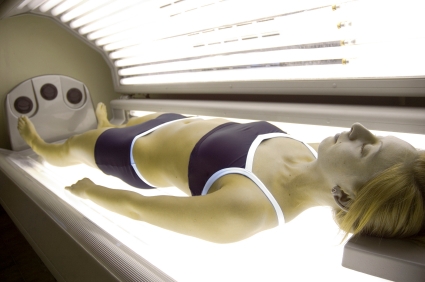Ultraviolet (UV) Radiation
Ultraviolet, or UV for short, radiation is invisible rays emitted from the sun. Scientifically speaking, ultraviolet radiation is defined as a form of electromagnetic radiation, the term used for any energy that moves at the speed of light. Ultraviolet rays are measured in waves and given a specific wavelength. Ironically, with smaller ultraviolet wavelengths, there is more potent ultraviolet radiation. Ultraviolet radiation also comes from tanning beds and lamps.
A healthy dose of ultraviolet radiation from the sunlight and medical artificial UV devices triggers the body to produce vitamin D. Vitamin D helps keep bones and teeth strong and healthy. In addition, some medical conditions are treated with ultraviolet radiation, such as vitiligo (a skin condition caused by an autoimmune disease). Someone who has vitiligo loses some of the brown skin pigmentation and is left with white blotches on the skin. Psoriasis, one of the most common skin conditions, is also caused by an autoimmune disease that affects roughly 7.5 million people, and this condition responds to UV rays. UV radiation is also used to treat lupus, eczema, and rickets.
Sources of UV Radiation
Ultraviolet radiation does not only come from the sun and artificial tanning devices, such as tanning beds and lamps. It also comes from a number of different –and unexpected – sources. These include:
- X-Ray machines – Each time you have an X-ray, you are exposed to ultraviolet radiation in low quantities. The level of radiation is so low that you do not need to be concerned, unless you have multiple X-rays over several years.
- Fluorescent light bulbs – Without a protective covering, these lighting sources also contain ultraviolet radiation. This is nothing to worry about, either, as all light bulbs are required to have a protective covering.
- LED lights – Also called light-emitting diodes, these are another source of ultraviolet radiation. LED lights are commonly found in digital printing devices.
- Laser engraving machines – These devices also contain ultraviolet radiation. However, they usually only contain a small amount of radiation. If you wear protective eyewear and other protective gear while working with the engravers, the ultraviolet radiation should not cause any problems for you. It is when users neglect to protect themselves over a long period of time that causes problems.
Sunburn
An unhealthy dose of ultraviolet radiation can wreak havoc on your body. A sunburn is an example of a mild version of too much ultraviolet radiation. While an extreme amount of ultraviolet radiation over a period of time can cause skin cancer, one sunburn will not. Be sure you protect yourself with sunscreen and avoid excessive time in the sun.
Types of UV Radiation Rays
There are three types of ultraviolet radiation rays. Type A and B are the two types that people are exposed to while outside in the sun, and they are those you get from tanning equipment. The third type, type C, is the most dangerous type. Luckily, it does not pose a threat to anyone because it cannot penetrate the ozone layer. We do not need to be concerned with type C.
Type A Ultraviolet Radiation
Type A is known as UVA radiation, and it has the longest wavelength. In direct sunlight, it can infiltrate the middle layer of your skin (called the dermis layer), which is the layer below the epidermis.
Type B Ultraviolet Radiation
Type B is known as UVB radiation, and it has a shorter wavelength. It can only infiltrate the outer layer of your skin (called the epidermis layer), which is the layer of skin that becomes sunburned.
Type C Ultraviolet Radiation
Type C is known as UVC radiation, and it has the shortest wavelength. As previously mentioned, it poses no threat. UVC wavelength is too short to infiltrate the Earth’s ozone layer.
The Ultraviolet Index
It is important to remember that if you are going to be outside, three things vary throughout the year. These include the amount of the ozone layer, cloud coverage, and the height of the sun. The ultraviolet index is forecast given by the National Weather Center each day. The index is based on three factors. These include:
- Sun Position – how high the sun is in the sky
- Cloud Cover – reported at each location (state)
- Atmospheric Ozone – how much of the ozone layer is in the atmosphere at each location (state)
The Ultraviolet Index Values and Exposure Category
The information below is from the National Weather Center.
INDEX VALUES EXPOSURE CATEGORY
0 – 2 Minimal
3 – 4 Low
5 – 6 Moderate
7 – 9 High
10 or greater Very high
Quick Facts about UV Radiation
- Smog can reduce the ultraviolet radiation strength.
- Reflective surfaces, such as snow, water and sand, can increase the exposure to UV rays.
- Late spring and early summer months produce the largest amount of ultraviolet radiation.
- The late fall and early winter months produce the least amounts of ultraviolet radiation.
- Partly cloudy days do not reduce the ultraviolet radiation.
- Rainy days and overcast days do greatly reduce the ultraviolet radiation.
- Being close to the equator, or living at a higher elevation, increases your index value.
- The ultraviolet radiation is at its peak at 1:00 pm – Daylight Savings Time.
- In the U.S., the peak exposure time of UV radiation is 50% less during the time three hours before and three hours after the peak exposure time.
Before you go outdoors for activities, check your local weather channel or the internet and see what the UV index value is for the day. Be sure to use sunscreen at all times, and if the index value is moderate or high, consider wearing a hat and an outfit that will provide some extra protection. You can be safe by knowing about UV radiation and how to protect yourself and your family.

